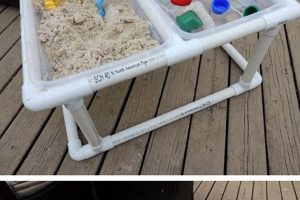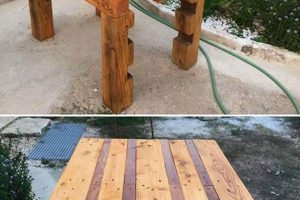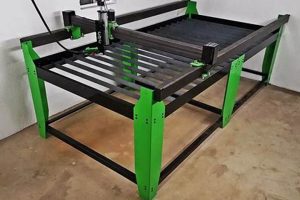The creation of a personalized tabletop surface using individual ceramic or similar material pieces is a popular home improvement endeavor. This project typically involves adhering these pieces to a prepared substrate, such as plywood or an existing table, followed by grouting to fill the spaces between them. The result is a durable and aesthetically customizable furniture element. Examples include mosaic-covered coffee tables, tiled kitchen islands, and decorative side tables.
This form of customized furniture construction offers several advantages. It allows for a high degree of design flexibility, enabling individuals to create unique patterns and color schemes. Furthermore, the resulting surface is generally water-resistant and easy to clean, making it suitable for high-use areas. Historically, the practice of incorporating tessellated surfaces into furniture and architectural elements dates back to ancient civilizations, reflecting a long-standing appreciation for both functional and decorative applications.
Subsequent sections will delve into the specific materials required for this type of project, detailing the necessary tools, exploring various design approaches, and providing step-by-step instructions for successful execution. Detailed consideration will also be given to appropriate grouting techniques and protective finishing methods to ensure longevity and visual appeal.
Key Considerations for Tiled Table Construction
The following section outlines essential considerations for achieving a durable and aesthetically pleasing tiled table surface. Adhering to these recommendations will contribute significantly to the project’s overall success and longevity.
Tip 1: Substrate Selection: The underlying material supporting the tiling is crucial. Plywood, cement board, or existing sturdy tabletops are suitable choices. Ensure the surface is level, clean, and properly prepared to accept adhesive.
Tip 2: Adhesive Compatibility: Select an adhesive specifically designed for bonding the chosen tile material to the selected substrate. Verify compatibility to prevent bond failure over time. Consider factors like moisture resistance and temperature fluctuations.
Tip 3: Tile Layout Planning: Before adhering any tiles, meticulously plan the layout. This step minimizes cutting and ensures a visually balanced and symmetrical arrangement. Dry-fitting tiles provides an opportunity to adjust spacing and refine the design.
Tip 4: Consistent Grout Lines: Employ tile spacers to maintain uniform grout lines. Consistent spacing contributes to a professional appearance and simplifies the grouting process. Select spacer sizes appropriate for the tile dimensions and desired aesthetic.
Tip 5: Grout Selection and Application: Choose a grout type appropriate for the intended use and environment. Consider factors such as moisture exposure and traffic. Apply grout evenly and meticulously, ensuring all spaces are completely filled.
Tip 6: Sealing the Grout: After the grout has cured completely, apply a grout sealer to protect it from stains and moisture penetration. This step is especially important in high-traffic or moisture-prone areas. Reapply sealer periodically as needed.
Tip 7: Edge Treatment: Address the exposed edges of the tiled surface. Options include bullnose tiles, metal edging, or wood trim. Select an edge treatment that complements the overall design and provides a durable and aesthetically pleasing finish.
Careful attention to these elements will result in a robust and visually appealing tiled table. Prioritizing preparation and using appropriate materials are key to achieving long-lasting results.
The subsequent section will present detailed instructions for project execution, covering material procurement and application techniques.
1. Surface Durability
Surface durability is a paramount consideration in the construction of a tiled table, directly influencing its lifespan and suitability for various applications. The ability of the tiled surface to withstand wear, impact, and environmental factors determines its long-term utility and aesthetic appeal. Careful selection of materials and construction techniques are critical to achieving adequate surface robustness.
- Material Hardness and Abrasion Resistance
The inherent hardness of the tile material directly correlates with its resistance to scratching and abrasion. Porcelain tiles, characterized by their high density and vitrification, offer superior hardness compared to ceramic or glass tiles. In high-traffic areas or applications where the table surface is subjected to frequent contact with objects, selecting tiles with a higher Mohs hardness rating is advisable to minimize surface wear and maintain visual integrity.
- Impact Resistance and Chip Resistance
Resistance to impact is a critical factor, particularly for tables located in environments where accidental impacts are likely. Thicker tiles and those with a higher density generally exhibit greater impact resistance. Moreover, the composition of the tile body influences its susceptibility to chipping. Tiles with a homogenous composition are less prone to chipping than those with a layered or less dense structure. Selecting tiles specifically rated for impact resistance is recommended for applications where this is a concern.
- Grout Selection and Durability
The grout lines between tiles are vulnerable to damage and staining if not properly selected and maintained. Epoxy grouts offer superior durability and stain resistance compared to cementitious grouts, making them a suitable choice for high-use areas or environments prone to spills and moisture. Furthermore, sealing grout lines with a quality grout sealer can significantly enhance their resistance to staining and water penetration, thereby contributing to the overall surface durability of the tiled table.
- Substrate Stability and Support
Even the most durable tiles will be susceptible to cracking or detachment if the underlying substrate is unstable or improperly prepared. The substrate must be rigid, level, and capable of supporting the weight of the tiles and adhesive. Using cement board as a substrate provides a stable and moisture-resistant foundation for the tiled surface. Proper bonding between the substrate, adhesive, and tiles is crucial for preventing movement and ensuring long-term adhesion, thereby maximizing the overall surface durability.
In summary, ensuring optimal surface durability in a tiled table necessitates a holistic approach, encompassing careful material selection, appropriate grout selection and sealing, and robust substrate preparation. By prioritizing these considerations, the resulting table will offer a durable and aesthetically pleasing surface capable of withstanding the rigors of daily use.
2. Design Aesthetics
Design aesthetics represent a critical factor in the construction of a tiled table, shaping its visual appeal and determining its integration into its intended environment. The aesthetic choices made throughout the project influence not only the table’s immediate attractiveness but also its long-term desirability and perceived value.
- Tile Selection: Color, Pattern, and Texture
The selection of tiles directly dictates the table’s visual character. Color palettes range from neutral to vibrant, influencing the mood and compatibility with surrounding decor. Patterns, whether geometric, floral, or abstract, introduce visual complexity and focal points. Tile texture, from smooth to highly tactile, adds a sensory dimension. For example, a table utilizing deep blue and white mosaic tiles evokes a Mediterranean aesthetic, while a table featuring large-format, smooth grey tiles projects a modern, minimalist image. These choices have significant implications for the table’s perceived style and suitability for various interior spaces.
- Grout Color and Line Width
The grout serves not only a functional purpose but also contributes significantly to the table’s overall aesthetic. Grout color can either blend seamlessly with the tiles or provide a contrasting accent, altering the perceived definition of the tile pattern. Narrow grout lines create a more refined, contemporary look, while wider lines can enhance a rustic or handcrafted aesthetic. For instance, using dark grout with light-colored tiles creates a high-contrast, graphic effect, while matching the grout color to the tiles results in a more uniform and subtle appearance. Grout width further influences this dynamic, playing a crucial role in design execution.
- Table Shape and Dimensions
The physical form of the tableits shape, height, and surface areainfluences its aesthetic impact and functional utility. A round table promotes conversation and informal gatherings, while a rectangular table may be better suited for dining or workspace applications. The table’s dimensions must be proportional to the surrounding space to avoid overwhelming or underutilizing the area. A small, square tiled table can serve as a decorative accent in a living room, while a large, rectangular tiled table can function as a centerpiece in a dining area. The size also determines the visual relationship within the room.
- Edge Treatment and Finishing Details
The treatment of the table’s edges and the incorporation of finishing details contribute to its overall aesthetic refinement. Options include bullnose tiles for a rounded edge, metal edging for a modern look, or wooden trim for a warm, traditional feel. The choice of finishwhether glossy, matte, or texturedfurther refines the table’s aesthetic character. Smooth, polished edges create a sophisticated, contemporary feel, while rough-hewn edges contribute to a rustic, artisanal aesthetic. These finishing touches provide opportunities to personalize the table and enhance its visual appeal.
These interconnected facets of design aesthetics collectively define the tiled table’s appearance and its compatibility with the surrounding environment. By carefully considering each elementfrom tile selection to finishing detailsthe builder can create a furniture piece that is not only functional but also a visually compelling addition to any space. These components offer examples of achieving a table design.
3. Material Selection
Material selection is a foundational element in the successful execution of any tiled table project. The characteristics of chosen materials directly influence the table’s durability, aesthetic appeal, and functional suitability for its intended environment. Careful consideration must be given to each component to ensure a cohesive and long-lasting final product.
- Tile Type and Properties
The type of tile selected dictates the table’s resistance to wear, moisture, and staining. Porcelain tiles, known for their density and low water absorption, are suitable for high-traffic areas or outdoor applications. Ceramic tiles offer a wider range of aesthetic options but may be less durable. Glass tiles provide unique visual appeal but require careful installation to prevent cracking. The inherent properties of each material must align with the intended use of the table. For example, a kitchen island benefits from the stain resistance of porcelain, while a decorative side table allows for the artistic expression afforded by glass.
- Substrate Composition and Stability
The substrate, or underlying support structure, plays a critical role in the long-term stability of the tiled surface. Plywood, cement board, and existing tabletops are common choices, each offering different levels of moisture resistance and structural integrity. Cement board is preferred for wet environments, while plywood requires sealing to prevent warping or decay. The substrate must be rigid, level, and capable of supporting the weight of the tiles and adhesive. Insufficient substrate stability can lead to cracking or detachment of the tiled surface over time. The substrate must be appropriately chosen based on materials
- Adhesive Compatibility and Bond Strength
The adhesive serves as the crucial link between the tiles and the substrate. Selecting an adhesive specifically formulated for the chosen tile material and substrate is essential for ensuring a strong and durable bond. Modified thin-set mortars offer excellent adhesion and flexibility, accommodating minor movements in the substrate. Epoxy-based adhesives provide superior water resistance and bond strength but require careful application. Incompatible adhesives can lead to tile delamination or failure. Proper adhesive selection, combined with meticulous application techniques, is vital for long-term performance.
- Grout Type and Performance Characteristics
The grout fills the spaces between tiles, providing a finished appearance and preventing water penetration. Cementitious grouts are cost-effective and readily available but are susceptible to staining and cracking. Epoxy grouts offer superior stain resistance, durability, and water impermeability but are more expensive and require specialized application techniques. Selecting the appropriate grout type depends on the intended use and aesthetic requirements of the table. A heavily used kitchen table would benefit from epoxy grout, but the cost might not be justified for a seldom-used patio table.
These intertwined elements underscore the pivotal role of judicious material selection in the construction of a durable and aesthetically pleasing tiled table. From choosing the right tile based on durability, to carefully planning the substrate materials, all are important in diy tile table. The selection of a strong adhesive and the long term considerations of grout combine to form a final product that aligns both functional needs and aesthetic desires.
4. Structural Integrity
The structural integrity of a tiled table directly dictates its load-bearing capacity, resistance to stress, and overall longevity. In this context, “Structural Integrity” and “diy tile table” are tightly connected. If it doesn’t have structural integrity, a table cannot function properly, and is prone to failure, rendering the DIY project useless. A weakened foundation can result in cracks in the grout, tile detachment, or even complete collapse of the tabletop. For example, a coffee table designed to support books and decorative items must possess sufficient structural soundness to prevent sagging or instability under sustained weight. Similarly, a kitchen island intended for food preparation and dining requires a robust frame capable of withstanding both static and dynamic loads.
Achieving adequate structural integrity in a tiled table involves several critical considerations. These involve choosing the proper materials such as the gauge of metal used for legs, to the thickness of the wood, all must be properly selected. The table’s frame must be constructed from materials with sufficient strength and stiffness to support the anticipated load. Proper joinery techniques, such as mortise-and-tenon joints or reinforced screw connections, are essential for creating a stable and durable frame. Moreover, the substrate upon which the tiles are adhered must be rigid and dimensionally stable to prevent cracking or warping. Reinforcement of the tabletop with additional bracing or a thicker substrate may be necessary to enhance its load-bearing capacity, for example, a large tabletop should use a thicker material, with bracing, to better distribute the load, and to keep the surface from warping.
In summary, the structural integrity of a tiled table is paramount for its safe and effective use. Neglecting this aspect during the design and construction phase can lead to premature failure, posing potential safety risks and negating the effort invested in the project. Prioritizing robust materials, sound construction techniques, and proper load distribution is crucial for creating a tiled table that withstands the test of time. A failure in design may lead to structural faults that are not obvious until it is too late, so considering all of the forces that the table will endure is a key factor in making a durable table.
5. Moisture Resistance
The durability and longevity of a “diy tile table” are critically dependent on its moisture resistance. Inadequate protection against water intrusion can lead to a cascade of detrimental effects, compromising structural integrity and aesthetic appeal. The porous nature of grout, combined with potential micro-cracks in the tile or substrate, creates pathways for moisture to penetrate the table’s core. This ingress can cause swelling and warping of the underlying wood or other substrate materials, resulting in tile delamination and surface distortion. Furthermore, prolonged moisture exposure fosters mold and mildew growth, posing health risks and degrading the table’s aesthetic quality. A tiled kitchen island subjected to frequent spills exemplifies the consequence of insufficient moisture resistance: grout discoloration, tile loosening, and eventual structural damage.
Implementing effective moisture-resistant measures during the construction phase is therefore paramount. Selecting non-porous tile materials, such as porcelain or glazed ceramic, minimizes water absorption. Employing epoxy-based grout, which offers superior impermeability compared to cementitious alternatives, creates a more robust barrier against moisture penetration. Applying a high-quality grout sealer after installation further enhances the table’s resistance to water damage. Ensuring proper drainage on tiled outdoor tables is another important consideration. Furthermore, choosing moisture-resistant substrates, such as cement board, provides a stable and durable foundation that resists warping and decay when exposed to damp conditions. Sealant is a major contributor to helping with moisture.
In summary, moisture resistance is an indispensable component of a successful “diy tile table” project. Its importance extends beyond mere aesthetic considerations, influencing the table’s structural integrity, hygiene, and overall lifespan. Diligent attention to material selection, grout application, and sealing techniques is essential to mitigate the risks associated with moisture exposure, ensuring a durable and aesthetically pleasing piece of furniture for years to come. A failure in planning for environmental exposure can lead to mold, rot, and complete destruction of the diy tile table. This is especially true for outdoor furniture projects.
6. Cost-Effectiveness
The economic advantages associated with constructing a tiled table, as opposed to purchasing a comparable pre-fabricated item, represent a primary motivator for many undertaking this type of project. The judicious selection of materials, coupled with the elimination of retail markups, often yields significant savings.
- Material Sourcing and Selection
The capacity to procure materials directly from suppliers, outlets, or even salvage yards allows for considerable cost reduction. Tiles, for example, can be purchased at discounted rates when sourced from overstock inventories or discontinued lines. Similarly, reclaimed wood or repurposed table bases offer viable and affordable alternatives to new components. However, cost savings should not compromise the quality or suitability of the materials for the intended application.
- Labor Cost Avoidance
Engaging in the construction process eliminates the labor costs typically incorporated into the price of manufactured furniture. The value of this avoided expense increases proportionally with the complexity of the design and the level of skilled craftsmanship required. While the project demands personal investment of time and effort, this can be viewed as an offset to direct financial outlay.
- Customization and Value Maximization
The option to tailor the table’s dimensions, design, and materials to specific needs and preferences enhances its perceived value. This customization avoids compromises often inherent in selecting mass-produced items, ensuring that the final product aligns perfectly with its intended purpose and aesthetic requirements. Furthermore, the unique character of a handmade table may contribute to its long-term appreciation.
- Long-Term Maintenance and Repair
Understanding the construction techniques and materials used facilitates future maintenance and repair. Addressing minor damages or imperfections becomes a manageable task, extending the lifespan of the table and avoiding the expense of replacement. This knowledge also empowers individuals to adapt or repurpose the table as their needs evolve.
These factors collectively contribute to the cost-effectiveness of building a tiled table. While initial material expenses may be comparable to lower-end retail options, the combination of customization, labor savings, and long-term maintainability often positions this approach as an economically sound alternative to purchasing mass-produced furniture. DIY offers an approach that is both economic and creative.
Frequently Asked Questions About DIY Tile Tables
The following section addresses common inquiries regarding the construction, maintenance, and suitability of tiled tables. The information presented is intended to provide clarity and inform decision-making for potential DIY projects.
Question 1: What tile types are best suited for tabletop applications?
Porcelain tiles are generally favored due to their durability, water resistance, and wide range of aesthetic options. Ceramic tiles offer a more affordable alternative but may be less resistant to chipping and staining. Glass tiles provide unique visual appeal but require careful handling during installation and may be susceptible to scratching. Natural stone tiles offer a luxurious aesthetic but necessitate sealing to prevent staining and moisture damage.
Question 2: What substrate materials provide the most stable base for a tiled tabletop?
Cement board is the preferred substrate for tiled tabletops due to its exceptional moisture resistance and dimensional stability. Plywood can be used as an alternative, but it requires sealing to prevent warping or decay. Existing tabletops can be re-tiled, provided they are structurally sound and free from loose coatings.
Question 3: What type of adhesive should be used to bond tiles to a tabletop substrate?
Modified thin-set mortar is generally recommended for bonding tiles to tabletop substrates. This type of adhesive offers excellent adhesion, flexibility, and water resistance. Epoxy-based adhesives provide superior bond strength and impermeability but require specialized application techniques and are typically more expensive.
Question 4: How should grout be selected to ensure durability and stain resistance in a tiled tabletop?
Epoxy grout is the preferred choice for tiled tabletops due to its exceptional stain resistance, durability, and water impermeability. Cementitious grout is a more affordable option but requires sealing to prevent staining and water damage. Selecting a grout color that complements the tile design enhances the aesthetic appeal of the finished product.
Question 5: What measures should be taken to ensure the longevity of a tiled tabletop in outdoor environments?
Selecting frost-resistant tiles is essential for outdoor applications. The substrate must be adequately sealed to prevent moisture penetration. Grout lines should be sealed to protect against staining and water damage. Providing adequate drainage to prevent water from pooling on the tabletop is also crucial.
Question 6: How can cracks or damaged tiles be repaired on a tiled tabletop?
Individual cracked or damaged tiles can be removed using a grout saw and chisel. The underlying adhesive should be cleaned thoroughly before installing a replacement tile. The replacement tile should be bonded to the substrate using the same type of adhesive as the original installation. Grout lines should be filled and sealed to match the surrounding grout.
These responses aim to address key considerations for potential tiled table projects. Further research and consultation with experienced professionals are recommended for complex or unconventional designs.
The following section will transition to practical application, outlining the tools and techniques involved in executing a DIY tile table project.
In Conclusion
This exploration of the “diy tile table” concept has illuminated its multifaceted aspects, encompassing design aesthetics, material selection, structural integrity, moisture resistance, and cost-effectiveness. From selecting appropriate tile types to ensuring proper substrate preparation and grout application, each element contributes to the overall success and longevity of the finished product. Understanding these key considerations empowers individuals to make informed decisions and execute a project that aligns with their specific needs and aesthetic preferences.
The creation of a durable and visually appealing tiled table represents a tangible investment in both functionality and personal expression. Whether intended for indoor or outdoor use, careful planning and execution are crucial for realizing the full potential of this endeavor. The knowledge imparted herein serves as a foundation for embarking on such a project, encouraging informed craftsmanship and fostering a deeper appreciation for the art of DIY furniture construction. Now it is up to the craftsperson to execute the table.







